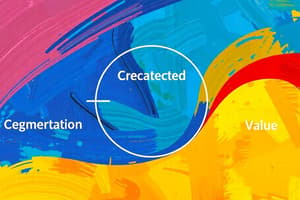Podcast
Questions and Answers
What represents the economic value of a customer to the firm?
What represents the economic value of a customer to the firm?
- Customer Loyalty
- Customer Satisfaction
- Customer Retention
- Customer Value (correct)
Which term describes the difference between what a consumer paid and their maximum willingness to pay?
Which term describes the difference between what a consumer paid and their maximum willingness to pay?
- Consumer Surplus (correct)
- Market Value
- Profit Margin
- Consumer Value
What does Earned Media refer to?
What does Earned Media refer to?
- Paid promotional content
- User-generated content through ads
- Free publicity from neutral media (correct)
- Coverage by paid influencers
How is Gross Margin Ratio calculated?
How is Gross Margin Ratio calculated?
What does Break-even Volume in Monetary Sales indicate?
What does Break-even Volume in Monetary Sales indicate?
Which of the following is a method of adjusting prices based on demand?
Which of the following is a method of adjusting prices based on demand?
What is the formula for calculating Gross Margin Ratio on Selling Price?
What is the formula for calculating Gross Margin Ratio on Selling Price?
What is defined as the information the firm seeks to improve marketing decision-making?
What is defined as the information the firm seeks to improve marketing decision-making?
Flashcards
Customer Value
Customer Value
The economic value of a customer to the firm. This measures how much a customer is worth to the business over their lifetime, considering their purchases, loyalty, and other factors.
Consumer Surplus
Consumer Surplus
The difference between the price a consumer paid for a product and the highest price they were willing to pay. It's the extra value a consumer gets because they paid less than they were prepared to.
Earned Media
Earned Media
Coverage in neutral media outlets who find your product or story interesting and relevant to their audience. It's exposure you get without directly paying for it.
Framing
Framing
Signup and view all the flashcards
Gross Margin Ratio
Gross Margin Ratio
Signup and view all the flashcards
Net Present Value (NPV)
Net Present Value (NPV)
Signup and view all the flashcards
Gross Margin Ratio per Unit
Gross Margin Ratio per Unit
Signup and view all the flashcards
Break-Even Volume in Monetary Sales
Break-Even Volume in Monetary Sales
Signup and view all the flashcards
Study Notes
Customer Value & Related Concepts
-
Customer Value: The economic value a customer brings to a firm.
-
Consumer Surplus: The difference between the price a consumer pays and the highest price they'd be willing to pay.
-
Earned Media: Media coverage generated by neutral sources interested in a product or story.
-
Framing: The context within which consumer decisions are made.
Marketing Metrics & Problems
-
Gross Margin Ratio per Unit: The difference between the selling price to the next distributor and the cost of goods sold (COGS) calculated per unit.
-
Gross Margin Ratio: A proportion that compares the gross margin to the cost of goods sold.
-
Marketing Problem: A decision, action, or issue a firm faces related to marketing strategy or the marketing mix.
-
Net Present Value (NPV): The difference between the present value of cash inflows and outflows over a period.
-
Price: How firms generate revenue, create cash flow, and make a profit.
-
Research Problem: Information a firm needs to make better marketing strategy decisions.
Market Share and Volume
-
Share in Monetary Value (MS[monetary]): The firm's sales value compared to the total market value.
-
Share in Units (MS[units]): The firm's unit sales compared to the total market units sold.
-
Unearned Media: Media coverage a firm pays for.
-
Unearned UGC: Paid endorsements/mentions from influencers or websites.
-
User-Generated Content (UGC): Content created by unpaid users.
-
Yield Management: Quickly adjusting prices based on predicted or current demand.
-
Break-even Volume in Monetary Sales (BEV[monetary sales]): The sales value needed to cover fixed costs.
-
Break-even Volume in Units (BEV[units]): The number of units needed to cover fixed costs.
-
Break-Even Volume in Market Share (BEV[market share]): The additional market share needed to break even.
-
S[units]: Quantity sold, expressed in units.
-
S[monetary]: Total sales revenue.
-
GM[cost]: Gross Margin ratio calculated using COGS.
-
GM[selling price]: Gross Margin ratio, based on the selling price.
-
BEV[units]: Calculation of break-even volume in units, using fixed costs and net profit margin per unit.
-
BEV[monetary sales]: Calculating break-even volume, in monetary sales, using the break-even volume in units and the selling price
-
BEV[unit market share]: break even volume expressed in market share, ( in units)
-
BEV[monetary market share]: break even volume expressed in market share (in monetary terms)
Studying That Suits You
Use AI to generate personalized quizzes and flashcards to suit your learning preferences.




